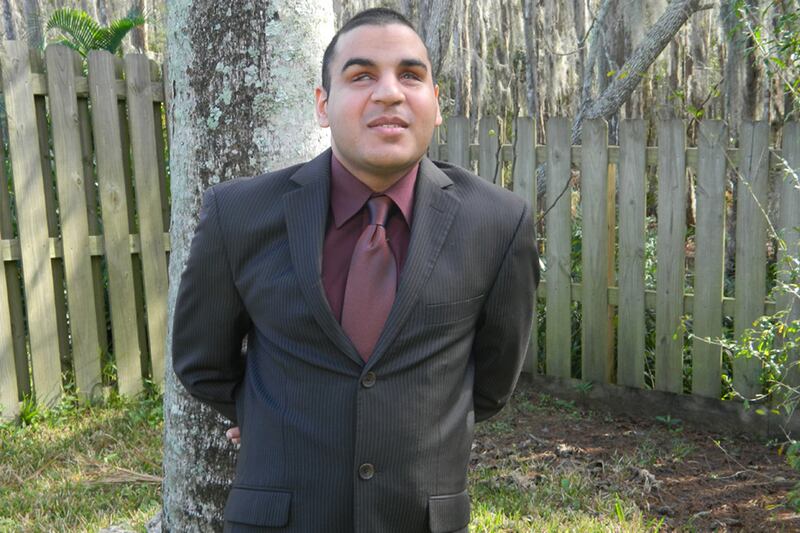Munawar Bijani made his foray into the world of videogames at age 8, as Ryu tossing fireballs at enemies in Street Fighter, and as Sub-Zero laying down sheets of ice in Mortal Kombat. He was pretty good, able to beat both computer and human opponents regularly enough to be a formidable foe.

Especially for a guy who’s completely blind.
Bijani could handle fighter games like that because they were two-dimensional—the characters could only move left and right—and because he could memorize how long it took to run from one side of the screen to the next, what it sounded like when they started into a spinning flying kick, and when to time his responding uppercut. He had fun, but he wanted more.
ADVERTISEMENT
Two years ago, Bijani finished designing the world’s first combat flight simulator for the blind: It is called Three-D Velocity, and it is now hugely popular. Gamers say it takes entertainment for the blind to the next level. Three-D Velocity sells for $43.99 on Bijani’s website, and it has been downloaded more than 11,000 times since it first launched. All for a game with no graphics, on a computer screen that is blank, except for the name at the top. It’s widely regarded as one of the best “audio games” on the market.
“It’s scaled down, but it’s detailed enough to where a blind person actually feels like they can fly a plane,” said Patrick Kelly, of Shawnee, Kans., blind since he was born prematurely and an avid “TDV” player.
Bijani was born with retinopathy and glaucoma, and his sight gradually disappeared during his first four years. Now he can barely remember what the world looks like, beyond a few basic colors. He grew up in Orlando, Fla., and always attended public schools in regular classrooms. He graduated high school with honors, two years after he designed his first game. Now he is at the forefront of a newly expanding field for blind entertainment options.
The first audio games were rudimentary, “turn-based.” The user typed basic commands—“a” for “attack number one” or “b” for “attack number two”—and then awaited the resulting announcement: how many points lost, whether the attack was successful, that kind of thing. They were played, largely, on a small device called “Braille Lite,” which is effectively a notetaker equipped with a modem, email capabilities, word processing, and some one-key commands.
There wasn’t much emphasis in those days on entertainment for blind people. Most research and technology went into making life more navigable for the blind: on transportation options, on software to allow them to work, or communicate. But everyone’s got down time, Bijani told The Daily Beast. “What do I do when it’s raining outside and I can’t go anywhere?” he said. It was with the Braille Lite that Bijani designed his first game, at age 16, called “Treasure Hunt,” in which the player uses a keyboard to search for treasure and avoid bad guys, with the vocal guidance prompting: “There’s an enemy here; do you want to fight it and get points, or just move on?”
He started selling Treasure Hunt in 2004, but by then there were others who’d begun to blaze a trail in more complicated audio games. The first three-dimensional game to hit the market may have been “Shades of Doom,” a Windows-based effort that uses a “multi-dimensional multi-layered sound” in which players use their ears to navigate from one level to the next, pinpointing enemies with pre-recorded voice warnings and increasingly intense beeps. The company also made a submarine game, and Bijani was quickly hooked on it. “My dad bought me that game for my 12th birthday,” he told The Daily Beast. “It was the best thing. I played it nonstop for hours at a time.”
Bijani wanted to try his hand at making 3D games, too. Watching “Top Gun”—with the help of a “descriptive video service” that reads out the action taking place on the screen—the youngster came up with his next big idea. “I thought, it would be so cool, if a blind person could actually fly a fighter jet,” he said.
To make a game that complex, though, Bijani had to learn Windows-based programming software by reading manuals in Braille that were hundreds of pages thick. He also taught himself how fighter jets move, recruited volunteers to help record the voiceovers and to program other sounds, and he found legions of other blind people eager to help him test the game. Three years after he started working on the project, Bijani unveiled Three-D Velocity, a game played on a nearly blank screen that allows users to imagine themselves taking off and landing, dodging helicopters firing rockets, and shooting their own missiles at enemy aircraft—all with only their fingers and ears. In the first two hours after launching it, Bijani recouped his $2,000 investment into Three D Velocity. Even after two years, the game continues to fly off the virtual shelves.
“When it first came out, I was losing sleep, playing until midnight or 1 in the morning,” Kelly said. “It’s the first real, accessible flight simulator the blind have ever had. I feel like I’m more in tune with the sighted world.”
Now, Bijani is working on the next version, which will come with multiplayer capabilities. After that, he’ll hire someone to add graphics to the game, so that sighted people can play online, against the blind. Once he finishes college this spring.





